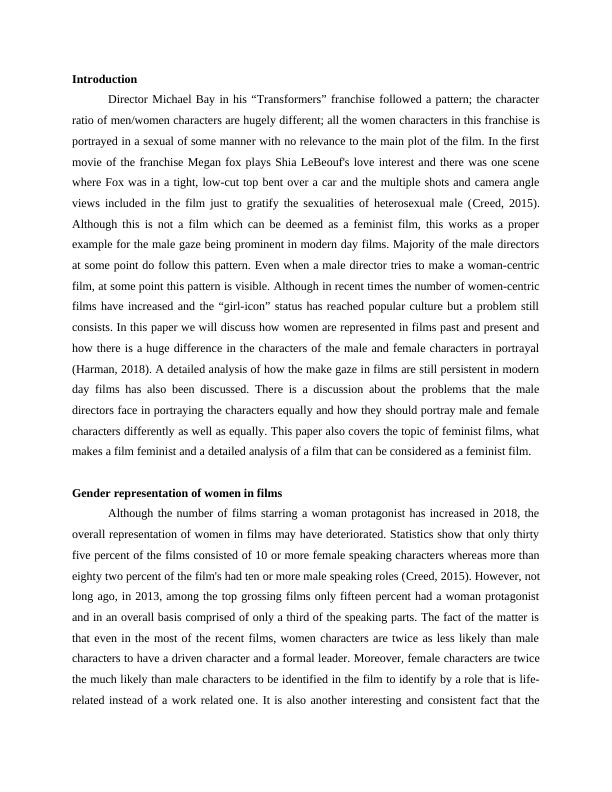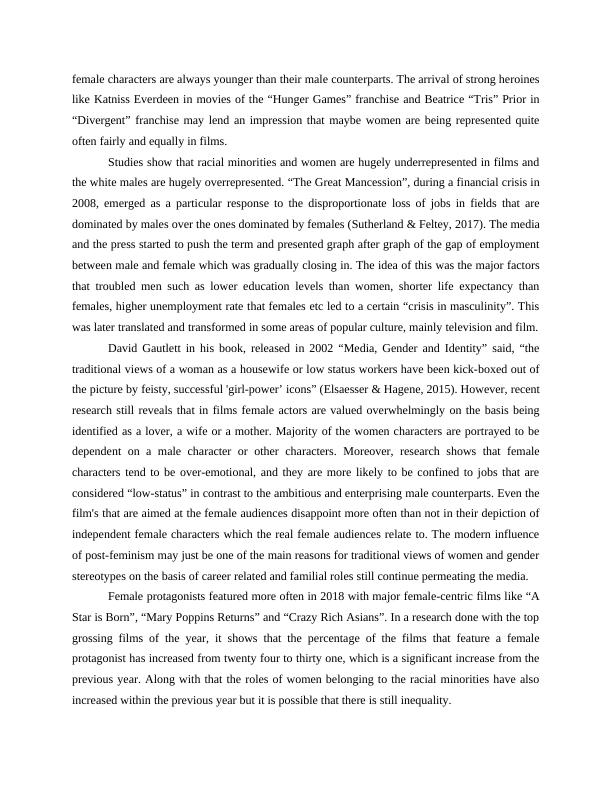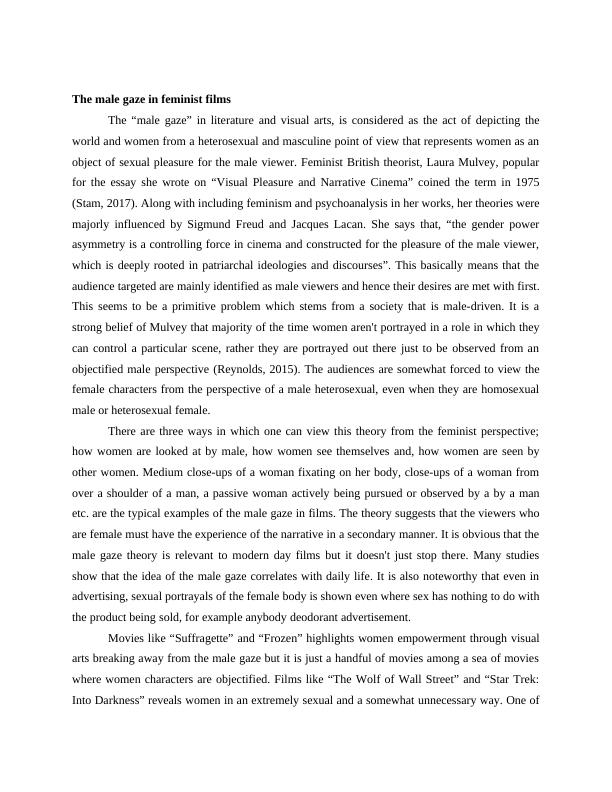The Transformers Franchise
Introduction and guidelines for the Extended Essay, including the nature of the EE, aims, regulations, responsibilities of students and supervisors, and a sample outline.
9 Pages3959 Words89 Views
Added on 2022-10-12
About This Document
Introduction Director Michael Bay in his “Transformers” franchise followed a pattern; the character ratio of men/women characters are hugely different; all the women characters in this franchise is portrayed in a sexual valued of some manner with no relevance to the main plot of the film. Gender representation of women in films Although the number of films starring a woman protagonist has increased in 2018, the overall representation of women in films may have deteriorated.
The Transformers Franchise
Introduction and guidelines for the Extended Essay, including the nature of the EE, aims, regulations, responsibilities of students and supervisors, and a sample outline.
Added on 2022-10-12
ShareRelated Documents
Introduction
Director Michael Bay in his “Transformers” franchise followed a pattern; the character
ratio of men/women characters are hugely different; all the women characters in this franchise is
portrayed in a sexual of some manner with no relevance to the main plot of the film. In the first
movie of the franchise Megan fox plays Shia LeBeouf's love interest and there was one scene
where Fox was in a tight, low-cut top bent over a car and the multiple shots and camera angle
views included in the film just to gratify the sexualities of heterosexual male (Creed, 2015).
Although this is not a film which can be deemed as a feminist film, this works as a proper
example for the male gaze being prominent in modern day films. Majority of the male directors
at some point do follow this pattern. Even when a male director tries to make a woman-centric
film, at some point this pattern is visible. Although in recent times the number of women-centric
films have increased and the “girl-icon” status has reached popular culture but a problem still
consists. In this paper we will discuss how women are represented in films past and present and
how there is a huge difference in the characters of the male and female characters in portrayal
(Harman, 2018). A detailed analysis of how the make gaze in films are still persistent in modern
day films has also been discussed. There is a discussion about the problems that the male
directors face in portraying the characters equally and how they should portray male and female
characters differently as well as equally. This paper also covers the topic of feminist films, what
makes a film feminist and a detailed analysis of a film that can be considered as a feminist film.
Gender representation of women in films
Although the number of films starring a woman protagonist has increased in 2018, the
overall representation of women in films may have deteriorated. Statistics show that only thirty
five percent of the films consisted of 10 or more female speaking characters whereas more than
eighty two percent of the film's had ten or more male speaking roles (Creed, 2015). However, not
long ago, in 2013, among the top grossing films only fifteen percent had a woman protagonist
and in an overall basis comprised of only a third of the speaking parts. The fact of the matter is
that even in the most of the recent films, women characters are twice as less likely than male
characters to have a driven character and a formal leader. Moreover, female characters are twice
the much likely than male characters to be identified in the film to identify by a role that is life-
related instead of a work related one. It is also another interesting and consistent fact that the
Director Michael Bay in his “Transformers” franchise followed a pattern; the character
ratio of men/women characters are hugely different; all the women characters in this franchise is
portrayed in a sexual of some manner with no relevance to the main plot of the film. In the first
movie of the franchise Megan fox plays Shia LeBeouf's love interest and there was one scene
where Fox was in a tight, low-cut top bent over a car and the multiple shots and camera angle
views included in the film just to gratify the sexualities of heterosexual male (Creed, 2015).
Although this is not a film which can be deemed as a feminist film, this works as a proper
example for the male gaze being prominent in modern day films. Majority of the male directors
at some point do follow this pattern. Even when a male director tries to make a woman-centric
film, at some point this pattern is visible. Although in recent times the number of women-centric
films have increased and the “girl-icon” status has reached popular culture but a problem still
consists. In this paper we will discuss how women are represented in films past and present and
how there is a huge difference in the characters of the male and female characters in portrayal
(Harman, 2018). A detailed analysis of how the make gaze in films are still persistent in modern
day films has also been discussed. There is a discussion about the problems that the male
directors face in portraying the characters equally and how they should portray male and female
characters differently as well as equally. This paper also covers the topic of feminist films, what
makes a film feminist and a detailed analysis of a film that can be considered as a feminist film.
Gender representation of women in films
Although the number of films starring a woman protagonist has increased in 2018, the
overall representation of women in films may have deteriorated. Statistics show that only thirty
five percent of the films consisted of 10 or more female speaking characters whereas more than
eighty two percent of the film's had ten or more male speaking roles (Creed, 2015). However, not
long ago, in 2013, among the top grossing films only fifteen percent had a woman protagonist
and in an overall basis comprised of only a third of the speaking parts. The fact of the matter is
that even in the most of the recent films, women characters are twice as less likely than male
characters to have a driven character and a formal leader. Moreover, female characters are twice
the much likely than male characters to be identified in the film to identify by a role that is life-
related instead of a work related one. It is also another interesting and consistent fact that the

female characters are always younger than their male counterparts. The arrival of strong heroines
like Katniss Everdeen in movies of the “Hunger Games” franchise and Beatrice “Tris” Prior in
“Divergent” franchise may lend an impression that maybe women are being represented quite
often fairly and equally in films.
Studies show that racial minorities and women are hugely underrepresented in films and
the white males are hugely overrepresented. “The Great Mancession”, during a financial crisis in
2008, emerged as a particular response to the disproportionate loss of jobs in fields that are
dominated by males over the ones dominated by females (Sutherland & Feltey, 2017). The media
and the press started to push the term and presented graph after graph of the gap of employment
between male and female which was gradually closing in. The idea of this was the major factors
that troubled men such as lower education levels than women, shorter life expectancy than
females, higher unemployment rate that females etc led to a certain “crisis in masculinity”. This
was later translated and transformed in some areas of popular culture, mainly television and film.
David Gautlett in his book, released in 2002 “Media, Gender and Identity” said, “the
traditional views of a woman as a housewife or low status workers have been kick-boxed out of
the picture by feisty, successful 'girl-power’ icons” (Elsaesser & Hagene, 2015). However, recent
research still reveals that in films female actors are valued overwhelmingly on the basis being
identified as a lover, a wife or a mother. Majority of the women characters are portrayed to be
dependent on a male character or other characters. Moreover, research shows that female
characters tend to be over-emotional, and they are more likely to be confined to jobs that are
considered “low-status” in contrast to the ambitious and enterprising male counterparts. Even the
film's that are aimed at the female audiences disappoint more often than not in their depiction of
independent female characters which the real female audiences relate to. The modern influence
of post-feminism may just be one of the main reasons for traditional views of women and gender
stereotypes on the basis of career related and familial roles still continue permeating the media.
Female protagonists featured more often in 2018 with major female-centric films like “A
Star is Born”, “Mary Poppins Returns” and “Crazy Rich Asians”. In a research done with the top
grossing films of the year, it shows that the percentage of the films that feature a female
protagonist has increased from twenty four to thirty one, which is a significant increase from the
previous year. Along with that the roles of women belonging to the racial minorities have also
increased within the previous year but it is possible that there is still inequality.
like Katniss Everdeen in movies of the “Hunger Games” franchise and Beatrice “Tris” Prior in
“Divergent” franchise may lend an impression that maybe women are being represented quite
often fairly and equally in films.
Studies show that racial minorities and women are hugely underrepresented in films and
the white males are hugely overrepresented. “The Great Mancession”, during a financial crisis in
2008, emerged as a particular response to the disproportionate loss of jobs in fields that are
dominated by males over the ones dominated by females (Sutherland & Feltey, 2017). The media
and the press started to push the term and presented graph after graph of the gap of employment
between male and female which was gradually closing in. The idea of this was the major factors
that troubled men such as lower education levels than women, shorter life expectancy than
females, higher unemployment rate that females etc led to a certain “crisis in masculinity”. This
was later translated and transformed in some areas of popular culture, mainly television and film.
David Gautlett in his book, released in 2002 “Media, Gender and Identity” said, “the
traditional views of a woman as a housewife or low status workers have been kick-boxed out of
the picture by feisty, successful 'girl-power’ icons” (Elsaesser & Hagene, 2015). However, recent
research still reveals that in films female actors are valued overwhelmingly on the basis being
identified as a lover, a wife or a mother. Majority of the women characters are portrayed to be
dependent on a male character or other characters. Moreover, research shows that female
characters tend to be over-emotional, and they are more likely to be confined to jobs that are
considered “low-status” in contrast to the ambitious and enterprising male counterparts. Even the
film's that are aimed at the female audiences disappoint more often than not in their depiction of
independent female characters which the real female audiences relate to. The modern influence
of post-feminism may just be one of the main reasons for traditional views of women and gender
stereotypes on the basis of career related and familial roles still continue permeating the media.
Female protagonists featured more often in 2018 with major female-centric films like “A
Star is Born”, “Mary Poppins Returns” and “Crazy Rich Asians”. In a research done with the top
grossing films of the year, it shows that the percentage of the films that feature a female
protagonist has increased from twenty four to thirty one, which is a significant increase from the
previous year. Along with that the roles of women belonging to the racial minorities have also
increased within the previous year but it is possible that there is still inequality.

The male gaze in feminist films
The “male gaze” in literature and visual arts, is considered as the act of depicting the
world and women from a heterosexual and masculine point of view that represents women as an
object of sexual pleasure for the male viewer. Feminist British theorist, Laura Mulvey, popular
for the essay she wrote on “Visual Pleasure and Narrative Cinema” coined the term in 1975
(Stam, 2017). Along with including feminism and psychoanalysis in her works, her theories were
majorly influenced by Sigmund Freud and Jacques Lacan. She says that, “the gender power
asymmetry is a controlling force in cinema and constructed for the pleasure of the male viewer,
which is deeply rooted in patriarchal ideologies and discourses”. This basically means that the
audience targeted are mainly identified as male viewers and hence their desires are met with first.
This seems to be a primitive problem which stems from a society that is male-driven. It is a
strong belief of Mulvey that majority of the time women aren't portrayed in a role in which they
can control a particular scene, rather they are portrayed out there just to be observed from an
objectified male perspective (Reynolds, 2015). The audiences are somewhat forced to view the
female characters from the perspective of a male heterosexual, even when they are homosexual
male or heterosexual female.
There are three ways in which one can view this theory from the feminist perspective;
how women are looked at by male, how women see themselves and, how women are seen by
other women. Medium close-ups of a woman fixating on her body, close-ups of a woman from
over a shoulder of a man, a passive woman actively being pursued or observed by a by a man
etc. are the typical examples of the male gaze in films. The theory suggests that the viewers who
are female must have the experience of the narrative in a secondary manner. It is obvious that the
male gaze theory is relevant to modern day films but it doesn't just stop there. Many studies
show that the idea of the male gaze correlates with daily life. It is also noteworthy that even in
advertising, sexual portrayals of the female body is shown even where sex has nothing to do with
the product being sold, for example anybody deodorant advertisement.
Movies like “Suffragette” and “Frozen” highlights women empowerment through visual
arts breaking away from the male gaze but it is just a handful of movies among a sea of movies
where women characters are objectified. Films like “The Wolf of Wall Street” and “Star Trek:
Into Darkness” reveals women in an extremely sexual and a somewhat unnecessary way. One of
The “male gaze” in literature and visual arts, is considered as the act of depicting the
world and women from a heterosexual and masculine point of view that represents women as an
object of sexual pleasure for the male viewer. Feminist British theorist, Laura Mulvey, popular
for the essay she wrote on “Visual Pleasure and Narrative Cinema” coined the term in 1975
(Stam, 2017). Along with including feminism and psychoanalysis in her works, her theories were
majorly influenced by Sigmund Freud and Jacques Lacan. She says that, “the gender power
asymmetry is a controlling force in cinema and constructed for the pleasure of the male viewer,
which is deeply rooted in patriarchal ideologies and discourses”. This basically means that the
audience targeted are mainly identified as male viewers and hence their desires are met with first.
This seems to be a primitive problem which stems from a society that is male-driven. It is a
strong belief of Mulvey that majority of the time women aren't portrayed in a role in which they
can control a particular scene, rather they are portrayed out there just to be observed from an
objectified male perspective (Reynolds, 2015). The audiences are somewhat forced to view the
female characters from the perspective of a male heterosexual, even when they are homosexual
male or heterosexual female.
There are three ways in which one can view this theory from the feminist perspective;
how women are looked at by male, how women see themselves and, how women are seen by
other women. Medium close-ups of a woman fixating on her body, close-ups of a woman from
over a shoulder of a man, a passive woman actively being pursued or observed by a by a man
etc. are the typical examples of the male gaze in films. The theory suggests that the viewers who
are female must have the experience of the narrative in a secondary manner. It is obvious that the
male gaze theory is relevant to modern day films but it doesn't just stop there. Many studies
show that the idea of the male gaze correlates with daily life. It is also noteworthy that even in
advertising, sexual portrayals of the female body is shown even where sex has nothing to do with
the product being sold, for example anybody deodorant advertisement.
Movies like “Suffragette” and “Frozen” highlights women empowerment through visual
arts breaking away from the male gaze but it is just a handful of movies among a sea of movies
where women characters are objectified. Films like “The Wolf of Wall Street” and “Star Trek:
Into Darkness” reveals women in an extremely sexual and a somewhat unnecessary way. One of

End of preview
Want to access all the pages? Upload your documents or become a member.
Related Documents
Sex Positive Postmodern Feminism in Sex and the Citylg...
|13
|4393
|285
